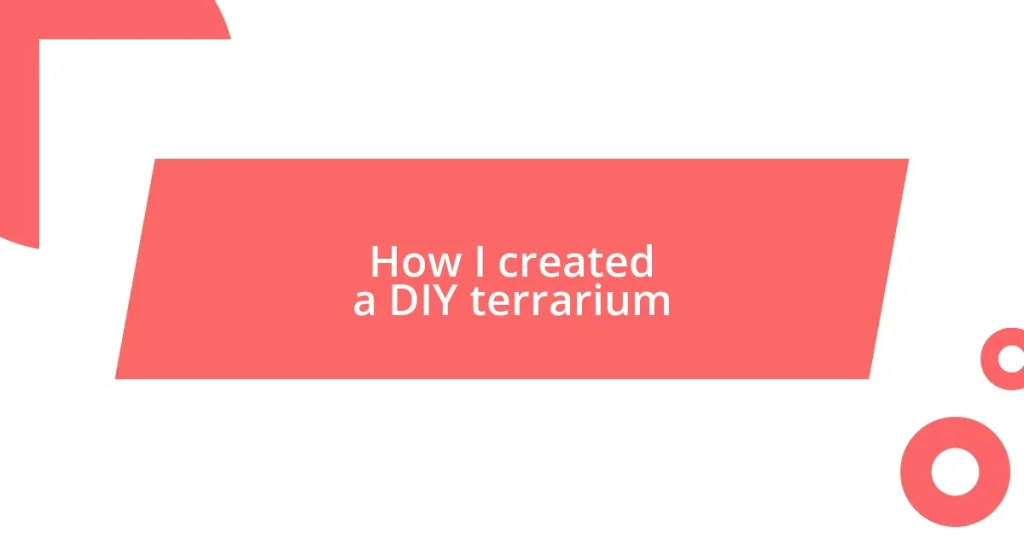Key takeaways:
- Choosing the right container is crucial for a terrarium’s success, considering size, material, and drainage options.
- Layering is essential; starting with stones for drainage, followed by activated charcoal, and high-quality potting soil creates a healthy environment for plants.
- Regular maintenance including watering, cleaning glass, and monitoring for issues like mold or pests ensures the terrarium thrives over time.
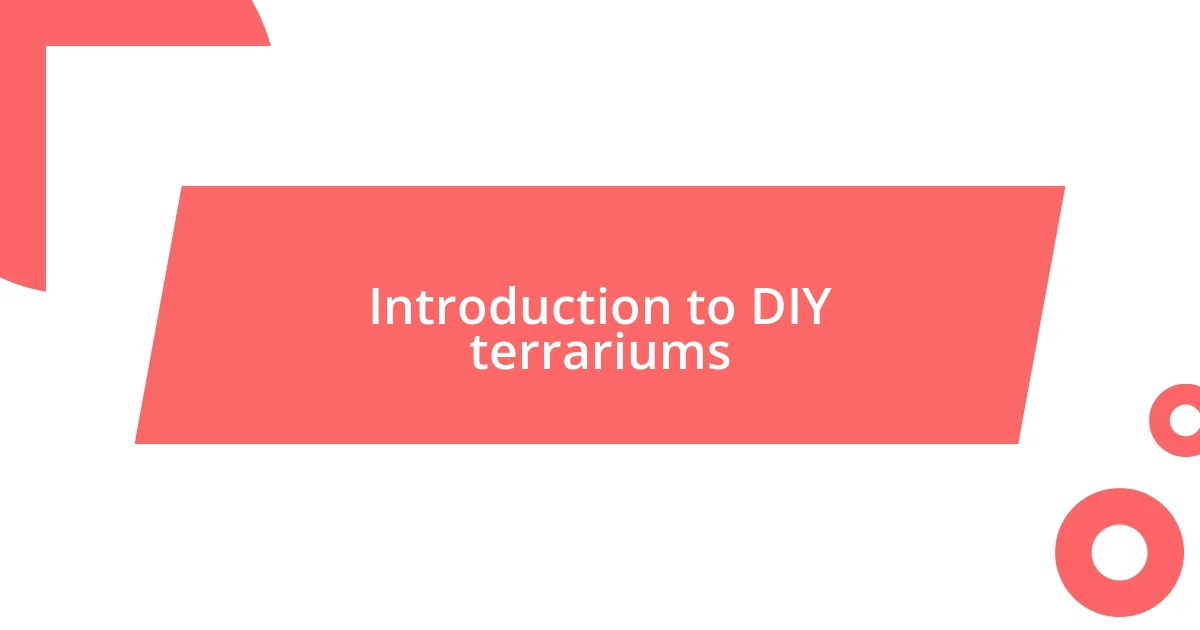
Introduction to DIY terrariums
Creating a DIY terrarium is like crafting a miniature world right in your home, and let me tell you, it’s an incredibly rewarding experience. I still remember the first time I put my hands into the soil, feeling the texture and smelling the earthiness—that sensory connection made the process so much more intimate.
Have you ever felt a little bit overwhelmed by the idea of maintaining houseplants? I certainly have. That’s what makes terrariums such a great choice! They’re not just beautiful to look at; they’re also low-maintenance ecosystems that can thrive on their own with minimal care. Building one can be as straightforward or as elaborate as you’d like, allowing your creativity to shine through while giving you a way to bring a slice of nature indoors.
For me, the moment I placed the last layer of moss on top was pure magic. There’s something truly special about nurturing a self-contained ecosystem, observing how each layer works together, much like a well-orchestrated symphony. Isn’t it fascinating how a few plants, some soil, and a little creativity can transform an empty glass vessel into a living art piece?
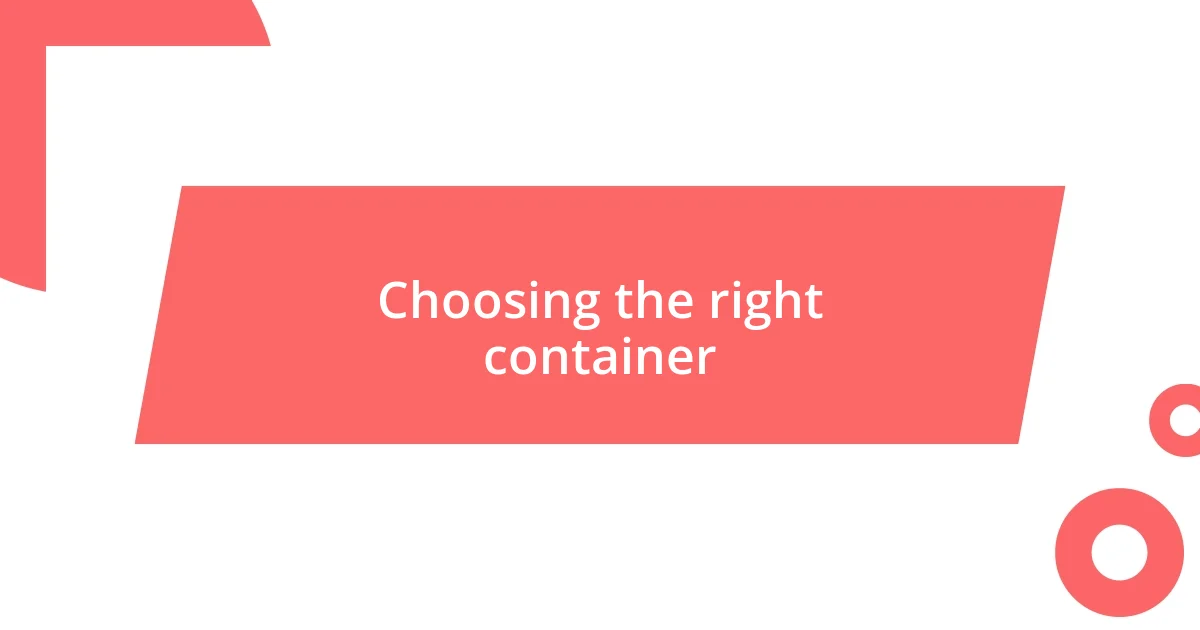
Choosing the right container
When it comes to choosing the right container for your terrarium, I’ve found that the size and shape truly matter. A larger container allows for a more diverse range of plants, while smaller ones can create a more intimate feel. I remember my first terrarium—a simple glass bowl. It was just the right size to hold a few succulents, and watching them thrive inside that little space was incredibly fulfilling.
I’ve experimented with various materials, from glass to ceramic, and each has its own character. Glass containers provide a stunning view of the layers inside, while ceramic can add a nice aesthetic touch. My favorite has become a vintage jar I picked up at a flea market. The moment I saw it, I envisioned a lush, green world trapped within its walls—and it didn’t disappoint!
Lastly, I think about drainage when selecting my containers. Adequate drainage prevents root rot, which is something I’ve learned the hard way—trust me, those soggy roots are not a pretty sight! I prefer using containers with small openings at the bottom or placing small stones to help with drainage. It’s this attention to detail that makes creating your own terrarium not just a project, but an adventure.
| Container Type | Pros |
|---|---|
| Glass | Beautiful visibility of layers; great for moisture retention |
| Ceramic | Stylish and sturdy; often has drainage options |
| Plastic | Lightweight and durable; good for beginners |

Selecting suitable plants
Selecting plants for your terrarium can really make or break the whole vibe of your miniature ecosystem. I often think back to the time I was at a local nursery, gazing at the vibrant greens and textures, completely captivated. It’s essential to choose plants that not only fit the size of your container but also create an interesting aesthetic from their varied heights, colors, and forms. I find that smaller varieties work best in a closed environment, allowing their beauty to shine.
Here are some kinds of plants I’ve had success with:
- Moss: Soft, lush, and perfect for the base layer to cover the soil.
- Succulents: Ideal for drier environments; they add a unique sculptural quality.
- Ferns: Bring a feathery texture; they love humidity and thrive in a glass container.
- Air plants: No soil needed! These quirky plants just need some light and air for nourishment.
- Miniature orchids: They introduce elegance and color, but they require a bit more care.
Picking the right plants requires a bit of feeling, almost like creating a family portrait where each plant has its own personality and needs. I remember placing a tiny succulent next to a fuzzy moss in my terrarium, and they just seemed to complement each other perfectly—it felt like I had orchestrated a little performance of nature!
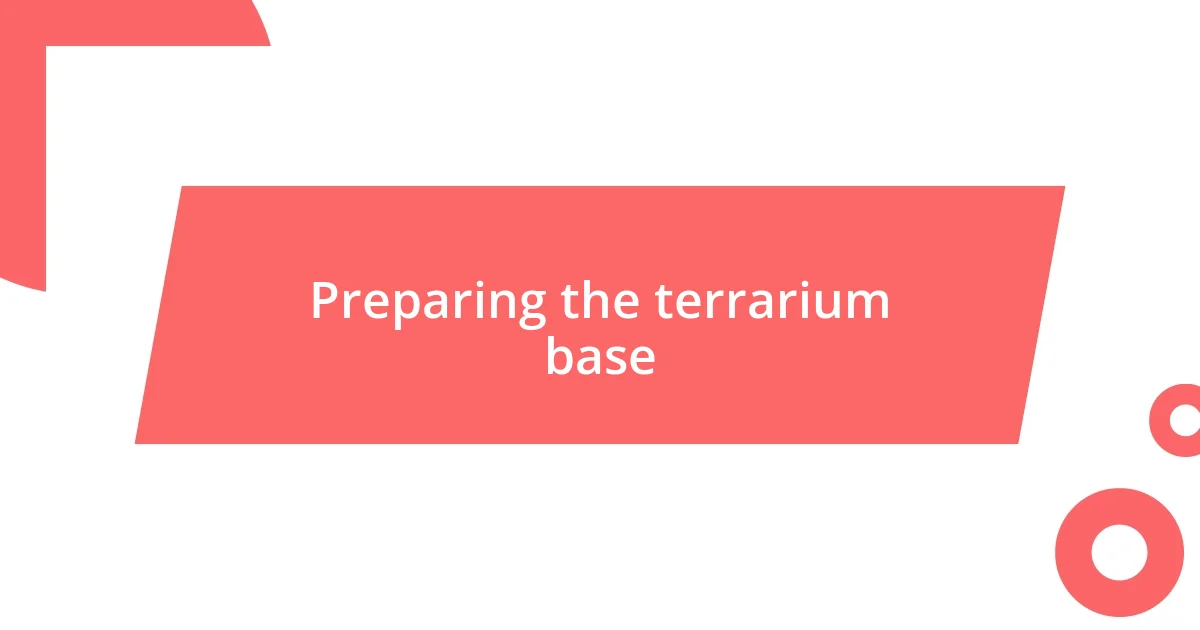
Preparing the terrarium base
To create a sturdy base for your terrarium, I always start with a layer of small stones or gravel. I remember the first time I neglected this step; it was a classic rookie mistake. Without drainage, my plants suffered, and the whole ecosystem I envisioned turned into a soggy mess. This initial layer not only helps excess water flow but also adds a nice aesthetic contrast to the greenery you’ll soon introduce.
Next, I sprinkle a thin layer of activated charcoal over the stones. This might sound like an unnecessary extra step, but trust me, it makes a world of difference! Activated charcoal helps filter the air and absorbs any odors, ensuring that your terrarium remains fresh and vibrant. I can’t help but smile when I realize how this simple addition can prevent any unwanted smells from creeping in—it’s like putting down the perfect foundation for a solid house!
Finally, I layer on high-quality potting soil, which is where the magic really begins. I’ve experimented with different soil types, and I always gravitate towards a well-draining mixture that promotes healthy root growth. As I position the plants into the soil, I often find myself imagining their journey in this new environment. It’s exciting to think about how they’ll thrive and interact with one another—in many ways, it’s like setting the stage for a delightful show, and I can’t wait to see the performance unfold!
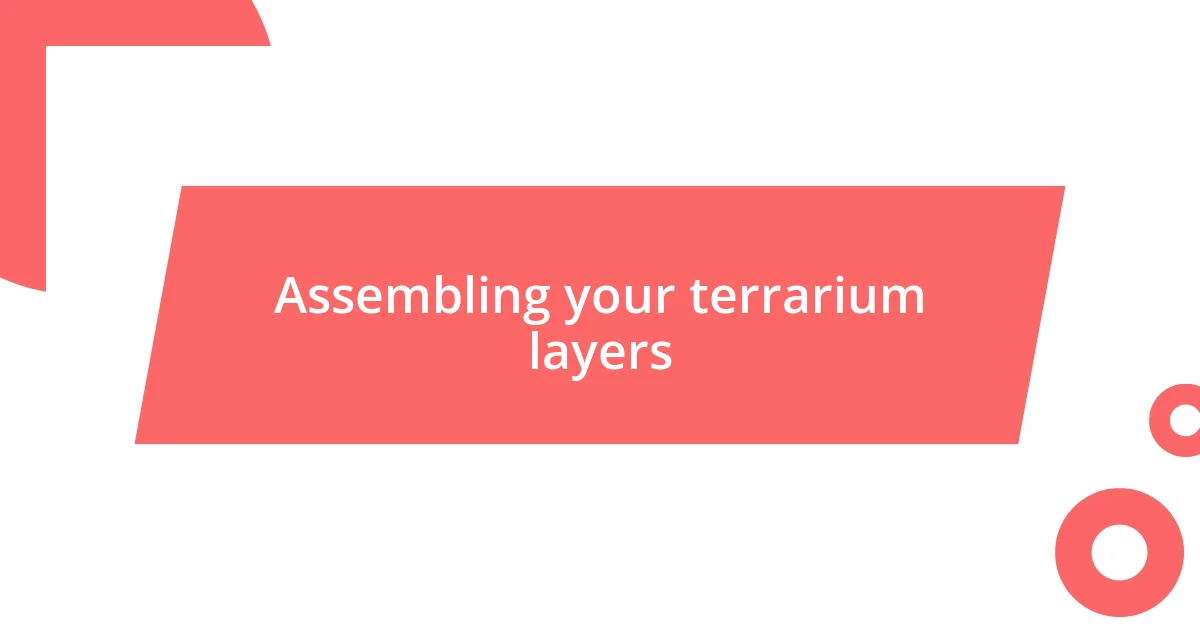
Assembling your terrarium layers
To assemble your terrarium layers, I always start by carefully adding that crucial layer of small stones or gravel. As I curl my fingers around the cool pebbles, I can’t help but remember the first time I tried to cut corners and skimped on drainage. It turned out to be a disaster! This layer is like the unsung hero of a terrarium; it keeps the roots from becoming waterlogged, ensuring my plants don’t just survive but thrive.
Next comes the activated charcoal, a step some might overlook. It feels like a hidden gem in the terrarium-building process. I still recall the joy of discovering how this little addition could effectively keep everything smelling fresh and clean. It’s almost a magical remedy that fights off any scents that might threaten my tiny world. How reassuring it is to know I have taken that extra measure to maintain a healthy environment for my plants!
Lastly, when I scoop in the potting soil, it feels like laying down a cozy blanket for my little green friends. I always dig deep to create a welcoming home for their roots. Sometimes, while I am planting, I get lost in daydreams of their growth journey—how bright colors will emerge and shapes will fill in over time. It’s this anticipation and connection to nature that pulls at my heartstrings, making me eager to see how each plant contributes to the intricate tapestry of my terrarium ecosystem.
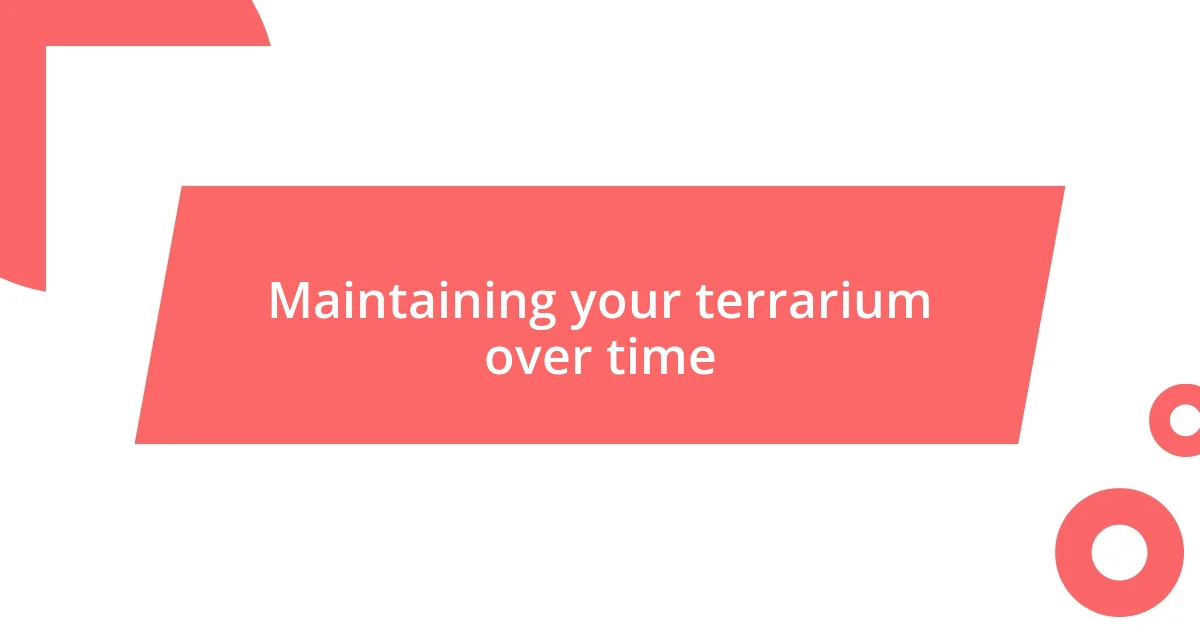
Maintaining your terrarium over time
Maintaining a terrarium is really about practicing attentive care. I remember the first time I noticed tiny specks of mold creeping up on my plants, which was both disheartening and a valuable lesson. It reminded me that while a terrarium creates its own little world, I still need to step in and help it thrive; regular monitoring is key to ensuring everything stays harmonious.
Watering can be a tricky business in a closed terrarium. I’ve found that it’s best to adopt a “less is more” approach. I recall the first time I mistakenly overwatered mine and ended up with a swampy habitat instead of the lush oasis I envisioned. Now, I always err on the side of caution, using a spray bottle for a gentle mist, which seems to keep the plants happy without overwhelming them. Have you ever wondered how much is too much? I’ve learned to trust my instincts and watch for signs from the plants—like droopy leaves or a soggy substrate—so that I can adjust as needed.
Cleaning the glass is another essential part of the maintenance routine. I used to ignore this, thinking it wouldn’t matter, but I was mistaken. Now, I cherish the moments spent wiping away the tiny spots that obscure my view. It’s like unlocking a magical realm every time I clear the glass; suddenly, I can really appreciate the vibrant colors and life inside. Plus, it helps the plants get as much light as possible—after all, they deserve their moment in the spotlight! Isn’t it reassuring to think that even small actions can have a huge impact on the health of your little ecosystem?
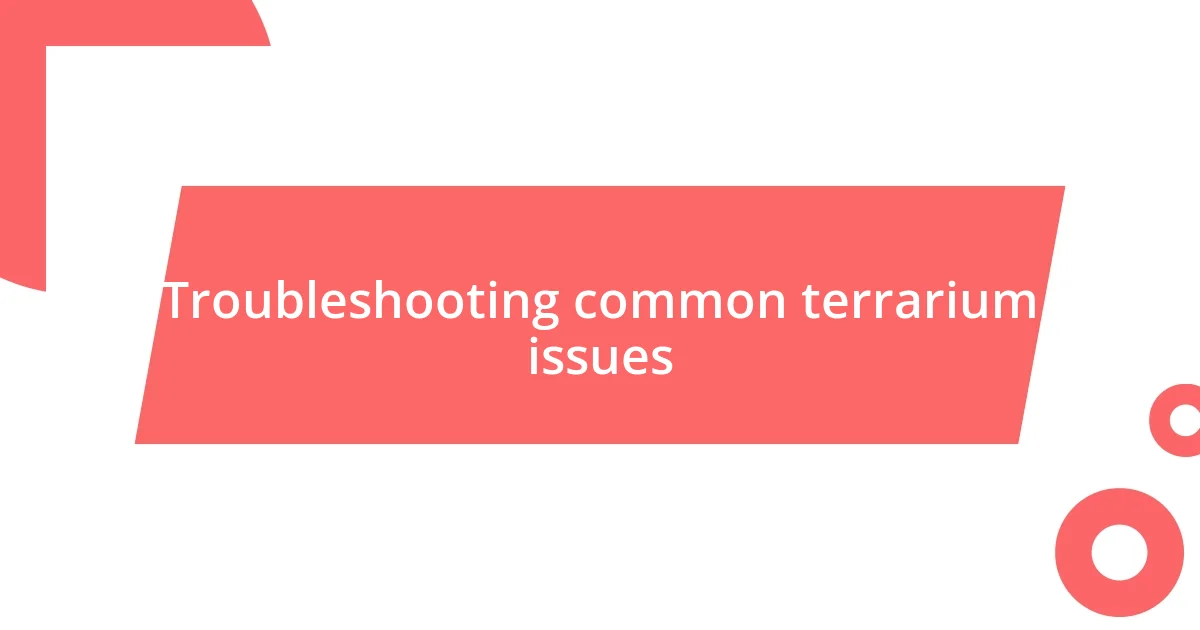
Troubleshooting common terrarium issues
Often, I’ve encountered problems like condensation building up inside the terrarium, which can lead to issues like mold. The first time I saw that foggy mist on the glass, I felt a pang of worry—would my plants suffocate? To combat this, I’ve learned to open the lid occasionally, allowing fresh air to circulate. A little ventilation goes a long way in keeping that delicate balance!
Another hiccup I faced was my terrarium looking way too leafy! At one point, I underestimated how quickly my plants would grow, and it became a jungle in there. Removing some of the overzealous growth was daunting, but it was a necessary thought process. Now, I check the plants regularly, gently pruning when needed to ensure each one has room to breathe and shine. Have you ever felt overwhelmed with the growth? It’s a testament to how well they’re thriving, but sometimes a little restraint is necessary!
And then there’s the dreaded pest invasion. I vividly recall discovering tiny little critters scuttling around my terrarium one evening, and my heart sank. I quickly realized that a simple mix of water and mild dish soap works wonders—along with isolating the affected plant until it’s pest-free. Have you faced a similar pest problem? It’s unsettling, but with proactive care, it’s manageable. Each challenge has taught me something new about the delicate art of nurturing such a complex ecosystem.










